Blog & Latest Updates
Fly Fishing Articles
Insects by Common Name


> > Mystery Creek # 249
About "Mystery Creeks": I love small streams, but some of my favorite little trout streams are too small and too fragile to publicize here. If you recognize one of these, you already understand why I'm keeping it a secret. These are the kinds of places that lose a little bit of their charm if you see someone else's week-old footprint, and I don't want to do that to them.
Closeup insects from Mystery Creek # 249
Drunella grandis (Western Green Drake) Mayfly Nymph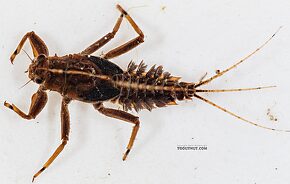 View 5 Pictures
View 5 Pictures
 View 5 Pictures
View 5 PicturesCollected July 4, 2020 from Mystery Creek #249 in Washington
Added to Troutnut.com by Troutnut on July 12, 2020
Added to Troutnut.com by Troutnut on July 12, 2020
Female Attenella delantala (Small Blue-Winged Olive) Mayfly Nymph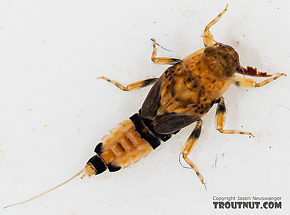 View 5 Pictures
View 5 Pictures
 View 5 Pictures
View 5 PicturesCollected July 25, 2019 from Mystery Creek #249 in Washington
Added to Troutnut.com by Troutnut on July 26, 2019
Added to Troutnut.com by Troutnut on July 26, 2019
Cinygmula (Dark Red Quills) Mayfly Nymph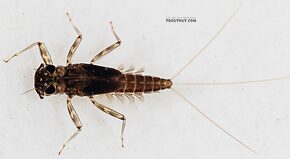 View 7 PicturesUnfortunately there's no good key to species of Cinygmula nymphs and I didn't find an adult, so this one will have to stay at genus level.
View 7 PicturesUnfortunately there's no good key to species of Cinygmula nymphs and I didn't find an adult, so this one will have to stay at genus level.
 View 7 PicturesUnfortunately there's no good key to species of Cinygmula nymphs and I didn't find an adult, so this one will have to stay at genus level.
View 7 PicturesUnfortunately there's no good key to species of Cinygmula nymphs and I didn't find an adult, so this one will have to stay at genus level.Collected July 6, 2020 from Mystery Creek #249 in Washington
Added to Troutnut.com by Troutnut on July 12, 2020
Added to Troutnut.com by Troutnut on July 12, 2020
Epeorus longimanus (Slate Brown Dun) Mayfly Nymph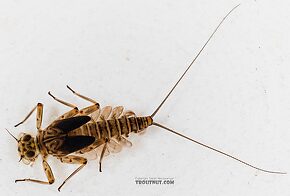 View 9 Pictures
View 9 Pictures
 View 9 Pictures
View 9 PicturesCollected July 4, 2020 from Mystery Creek #249 in Washington
Added to Troutnut.com by Troutnut on July 12, 2020
Added to Troutnut.com by Troutnut on July 12, 2020
Male Rhithrogena hageni (Western Black Quill) Mayfly Spinner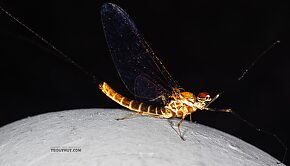 View 15 PicturesI collected this spinner from the trail (old logging road) above a whitewater canyon on a small stream in the Cascades. I'm fairly positive on the ID: in Traver 1935 it keys out to Rhithrogena doddsi, which is now a synonym (Synonym: A former name of a taxon, usually a species. Entomologists frequently discover that two insects originally described as different species are one in the same, and they drop one of the names. The dropped name is said to be a synonym of the remaining name. These changes take a while to trickle into the common knowledge of anglers; for example, Baetis vagans is now a synonym of Baetis tricaudatus.) of Rhithrogena hageni. The penes (Penes: The paired genital structures of most male insects, which vary widely in form and are one of the main characteristics used for species identification.) differ slightly from the drawing in that book, but they're a very close match to drawing from the original hageni description in Eaton 1885.
View 15 PicturesI collected this spinner from the trail (old logging road) above a whitewater canyon on a small stream in the Cascades. I'm fairly positive on the ID: in Traver 1935 it keys out to Rhithrogena doddsi, which is now a synonym (Synonym: A former name of a taxon, usually a species. Entomologists frequently discover that two insects originally described as different species are one in the same, and they drop one of the names. The dropped name is said to be a synonym of the remaining name. These changes take a while to trickle into the common knowledge of anglers; for example, Baetis vagans is now a synonym of Baetis tricaudatus.) of Rhithrogena hageni. The penes (Penes: The paired genital structures of most male insects, which vary widely in form and are one of the main characteristics used for species identification.) differ slightly from the drawing in that book, but they're a very close match to drawing from the original hageni description in Eaton 1885.
I'm using its ID to put a species ID on a female dun and mature nymph collected on the same trip. I'm also using this one's ID for a specimen with seemingly identical reproductive anatomy from Montana.
Lastly, I have included here a couple pictures of the genitalia of a different specimen collected on the same evening, from the same river, and I think even the same swarm (although I don't recall that 100 %). They're angled a bit differently, and I couldn't locate the mid-ventral (Ventral: Toward or on the bottom.) spines, but I'm guessing I'm just seeing intra-species variation.
 View 15 PicturesI collected this spinner from the trail (old logging road) above a whitewater canyon on a small stream in the Cascades. I'm fairly positive on the ID: in Traver 1935 it keys out to Rhithrogena doddsi, which is now a synonym (Synonym: A former name of a taxon, usually a species. Entomologists frequently discover that two insects originally described as different species are one in the same, and they drop one of the names. The dropped name is said to be a synonym of the remaining name. These changes take a while to trickle into the common knowledge of anglers; for example, Baetis vagans is now a synonym of Baetis tricaudatus.) of Rhithrogena hageni. The penes (Penes: The paired genital structures of most male insects, which vary widely in form and are one of the main characteristics used for species identification.) differ slightly from the drawing in that book, but they're a very close match to drawing from the original hageni description in Eaton 1885.
View 15 PicturesI collected this spinner from the trail (old logging road) above a whitewater canyon on a small stream in the Cascades. I'm fairly positive on the ID: in Traver 1935 it keys out to Rhithrogena doddsi, which is now a synonym (Synonym: A former name of a taxon, usually a species. Entomologists frequently discover that two insects originally described as different species are one in the same, and they drop one of the names. The dropped name is said to be a synonym of the remaining name. These changes take a while to trickle into the common knowledge of anglers; for example, Baetis vagans is now a synonym of Baetis tricaudatus.) of Rhithrogena hageni. The penes (Penes: The paired genital structures of most male insects, which vary widely in form and are one of the main characteristics used for species identification.) differ slightly from the drawing in that book, but they're a very close match to drawing from the original hageni description in Eaton 1885.I'm using its ID to put a species ID on a female dun and mature nymph collected on the same trip. I'm also using this one's ID for a specimen with seemingly identical reproductive anatomy from Montana.
Lastly, I have included here a couple pictures of the genitalia of a different specimen collected on the same evening, from the same river, and I think even the same swarm (although I don't recall that 100 %). They're angled a bit differently, and I couldn't locate the mid-ventral (Ventral: Toward or on the bottom.) spines, but I'm guessing I'm just seeing intra-species variation.
Collected July 4, 2020 from Mystery Creek #249 in Washington
Added to Troutnut.com by Troutnut on July 12, 2020
Added to Troutnut.com by Troutnut on July 12, 2020
Male Ephemerella excrucians (Pale Morning Dun) Mayfly Nymph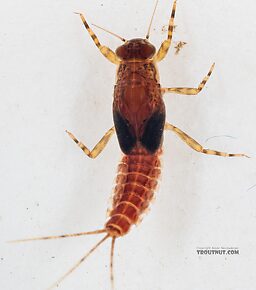 View 11 PicturesI used the ID of this nymph (and some others like it) to infer the identity of a female dun collected on the same trip.
View 11 PicturesI used the ID of this nymph (and some others like it) to infer the identity of a female dun collected on the same trip.
 View 11 PicturesI used the ID of this nymph (and some others like it) to infer the identity of a female dun collected on the same trip.
View 11 PicturesI used the ID of this nymph (and some others like it) to infer the identity of a female dun collected on the same trip.Collected July 4, 2020 from Mystery Creek #249 in Washington
Added to Troutnut.com by Troutnut on July 12, 2020
Added to Troutnut.com by Troutnut on July 12, 2020
Female Rhithrogena hageni (Western Black Quill) Mayfly Dun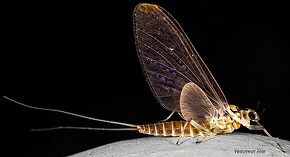 View 7 PicturesI was surprised by the olive cast on the body of this female Rhithrogena dun, which led me to mistake it for a western green drake (Drunella) in the field. I was pleasantly surprised to get a closer look and find something I hadn't collected yet. Its species ID is based on proximity to male spinner collected on the same trip, as well as physical similarity (size, tergite (
View 7 PicturesI was surprised by the olive cast on the body of this female Rhithrogena dun, which led me to mistake it for a western green drake (Drunella) in the field. I was pleasantly surprised to get a closer look and find something I hadn't collected yet. Its species ID is based on proximity to male spinner collected on the same trip, as well as physical similarity (size, tergite (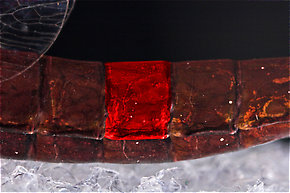 Tergite: The top (dorsal) part of a single segment on an insect's abdomen when it consists of a single chitinous plate (sclerite), or an individual sclerite if the segment has more than one.) coloration, dark streaks on the femora (
Tergite: The top (dorsal) part of a single segment on an insect's abdomen when it consists of a single chitinous plate (sclerite), or an individual sclerite if the segment has more than one.) coloration, dark streaks on the femora (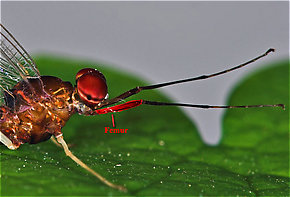 Femur: The main segment of an insect's leg close to the body, in between the tibia and the trochanter.)) to that specimen.
Femur: The main segment of an insect's leg close to the body, in between the tibia and the trochanter.)) to that specimen.
 View 7 PicturesI was surprised by the olive cast on the body of this female Rhithrogena dun, which led me to mistake it for a western green drake (Drunella) in the field. I was pleasantly surprised to get a closer look and find something I hadn't collected yet. Its species ID is based on proximity to male spinner collected on the same trip, as well as physical similarity (size, tergite (
View 7 PicturesI was surprised by the olive cast on the body of this female Rhithrogena dun, which led me to mistake it for a western green drake (Drunella) in the field. I was pleasantly surprised to get a closer look and find something I hadn't collected yet. Its species ID is based on proximity to male spinner collected on the same trip, as well as physical similarity (size, tergite (
One tergite of this Isonychia bicolor mayfly spinner is highlighted in red.

The femur of this Isonychia bicolor mayfly spinner is highlighted in red.
Collected July 4, 2020 from Mystery Creek #249 in Washington
Added to Troutnut.com by Troutnut on July 12, 2020
Added to Troutnut.com by Troutnut on July 12, 2020
Chironomidae (Midges) Midge Larva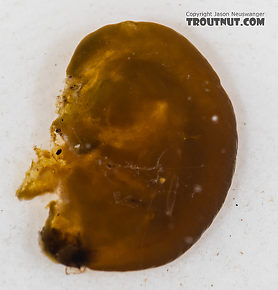 View 8 PicturesThese larvae were all over the submerged rocks in a small mountain stream in the Washington Cascades, tightly adhering to the rocks in their flat, half-disk-shaped cases.
View 8 PicturesThese larvae were all over the submerged rocks in a small mountain stream in the Washington Cascades, tightly adhering to the rocks in their flat, half-disk-shaped cases.
 View 8 PicturesThese larvae were all over the submerged rocks in a small mountain stream in the Washington Cascades, tightly adhering to the rocks in their flat, half-disk-shaped cases.
View 8 PicturesThese larvae were all over the submerged rocks in a small mountain stream in the Washington Cascades, tightly adhering to the rocks in their flat, half-disk-shaped cases.Collected July 25, 2019 from Mystery Creek #249 in Washington
Added to Troutnut.com by Troutnut on July 27, 2019
Added to Troutnut.com by Troutnut on July 27, 2019
Female Suwallia pallidula (Sallfly) Stonefly Adult View 6 PicturesI didn't key this one out under the microscope, but I just keyed a similar one from Montana and this one matches the macroscopic appearance closely enough that I'm guessing it's the same thing.
View 6 PicturesI didn't key this one out under the microscope, but I just keyed a similar one from Montana and this one matches the macroscopic appearance closely enough that I'm guessing it's the same thing.
 View 6 PicturesI didn't key this one out under the microscope, but I just keyed a similar one from Montana and this one matches the macroscopic appearance closely enough that I'm guessing it's the same thing.
View 6 PicturesI didn't key this one out under the microscope, but I just keyed a similar one from Montana and this one matches the macroscopic appearance closely enough that I'm guessing it's the same thing.Collected July 4, 2020 from Mystery Creek #249 in Washington
Added to Troutnut.com by Troutnut on July 12, 2020
Added to Troutnut.com by Troutnut on July 12, 2020
Coleoptera (Beetles) Beetle Larva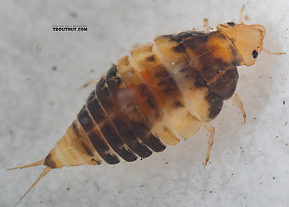 View 3 Pictures
View 3 Pictures
 View 3 Pictures
View 3 PicturesCollected July 25, 2019 from Mystery Creek #249 in Washington
Added to Troutnut.com by Troutnut on July 27, 2019
Added to Troutnut.com by Troutnut on July 27, 2019
Recent Discussions of Mystery Creek # 249
Awesome
Posted by PABrownie on Jul 29, 2019
Now this is what I'm talking about. Great write-up and photos!
Cheers!
ReplyCheers!
Start a Discussion of Mystery Creek # 249:
Top 10 Fly Hatches
Top Gift Shop Designs
Eat mayflies.
Top Insect Specimens
Miscellaneous Sites
Troutnut.com is copyright © 2004-2024 Jason
Neuswanger (email Jason). See my FAQ for information about use of my images.
 privacy policy
privacy policy
